Wound healing is a complex cascade of events injured living tissues undergo to repair themselves to as close to normalcy as possible. For patients considering a hair transplant, the issue of wound healing and FUE recovery time often sits at the forefront of the mind. Body hair transplant involves the use of hair grafts from non-head areas such as the beard, chest, stomach, arms, or legs to balding areas. With the invention of Dr.UGraft, Dr. Umar took patient concerns to heart and designed a tool that minimizes wound size and promotes rapid, aesthetically pleasing FUE wound healing.[1]
The following video elaborates on the FUE hair transplant recovery process after Dr.UGraft:
Better Would Healing with the UGraft Advanced FUE
No Description
Extraction Wounds: The FUE Healing Process
Wounds are inevitable when dealing with hair transplantation surgery. In body hair transplantation procedures, slight discolorations or scarring can occur in far more visible areas. Patients should thus become familiar with FUE wound healing and scar prevention.
Follicular unit extractions have improved the wound-healing process of typical hair transplant procedures. Techniques and the hair transplant recovery timeline have also evolved. The integrity of grafts extracted and the size and type of wounds left after extraction contributes to how a wound heals.
The image below show’s a patient’s beard donor area after healing.
-
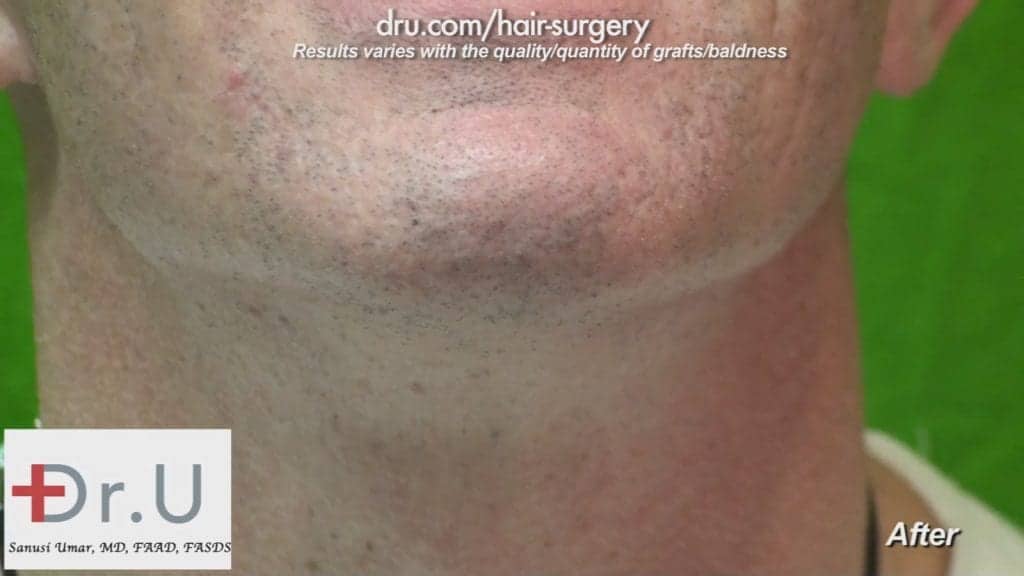
This patient underwent hair restoration using the beard area as a donor pool. This image shows the area after healing.*
Finding a balance between these two factors contributes to how the graft takes root in the incision and the amount of time the wound takes to heal. An ideal extraction and implantation contain the least amount of extraneous tissue attached to the graft.
FUE Hair Transplant Recovery Time Depends on Medical Precision
Medical precision means that only the essential tissue would be removed from the skin during follicle extraction. A smaller wound equals faster healing for the skin and improves the graft’s viability. Additionally, when performed correctly using the right tools like Dr.UGraft, wounds tend to collapse into themselves along with the epidermis. These wounds create a self-seal that aids healing time as well.
Patients should note that the ability of Dr.UGraft to transplant without obvious scarring allows for hair transplant from anywhere on the body. The video below details a patient’s case history who underwent Dr.UGraft to restore a head of hair. Dr. Umar selected grafts from the patient’s beard to complete the work. However, note that the procedure did not create visible scarring, even in a sensitive area like the face:
Los Angeles Best FUE Hair Transplant Repair Success Story Using Beard and Body Hair
No Description
The patient underwent strip surgery at another clinic for 1800 grafts, and was unhappy with his hairline, coverage, and strip scar. He did not have enough head hair to continue traditional transplants, but he was still bald. He underwent three surgeries: 3800 beard grafts, 1500 nape, and chest grafts, and 500 head grafts. Dr. U created a new hairline and temple points, added density to the front, middle, and crown, and added hair to the strip scar. The patient is seen one year after his DrUGraft procedure.
-
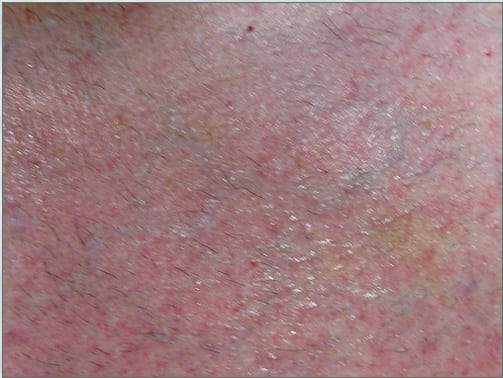
FUE wound healing due to Dr.UGraft extraction process, 3 hours post-op.*
Skill and technique both play essential roles in successful surgeries. Dr.UGraft, an advanced follicular unit extraction surgical system, was developed by Dr. Umar to succeed in the area of body hair to head transplantation.
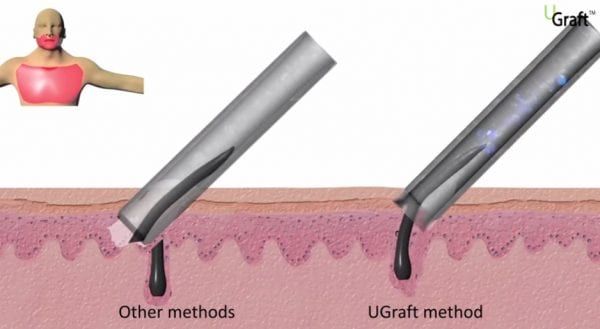
- The accuracy of The Intelligent Punch innovative extraction compared to basic FUE processes.
Basic FUE devices extract the follicle in a funnel-like shape, leaving a larger wound behind. Larger wounds increase the likelihood of scarring and other complications in a patient’s recovery from a hair transplant. Dr.UGraft, by comparison, removes the follicle with a smaller incision that leads to faster FUE wound healing times with less scarring.
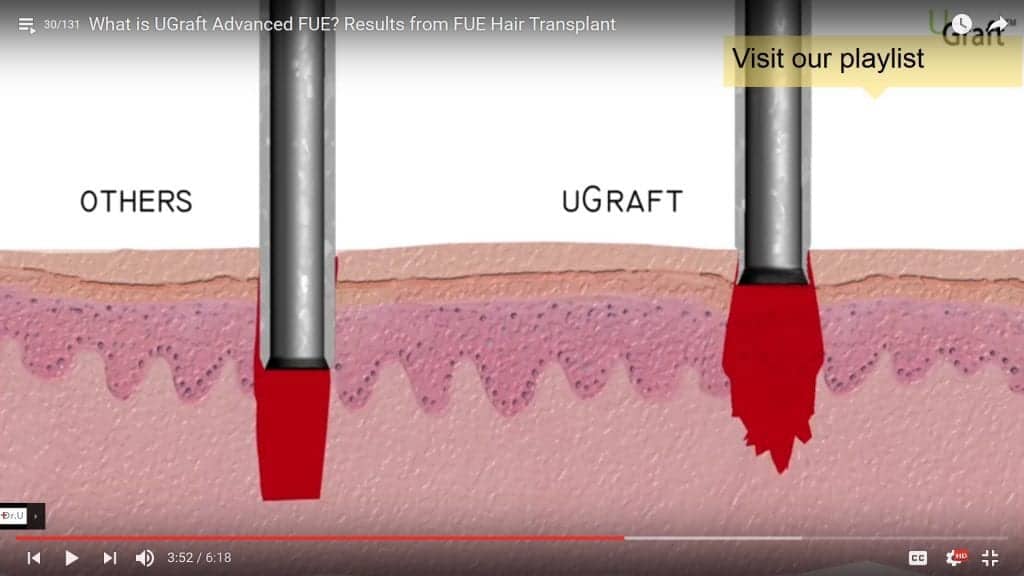
- The Intelligent Punch tool, the key innovation of Dr.UGraft, can transplant any hair regardless of curl.
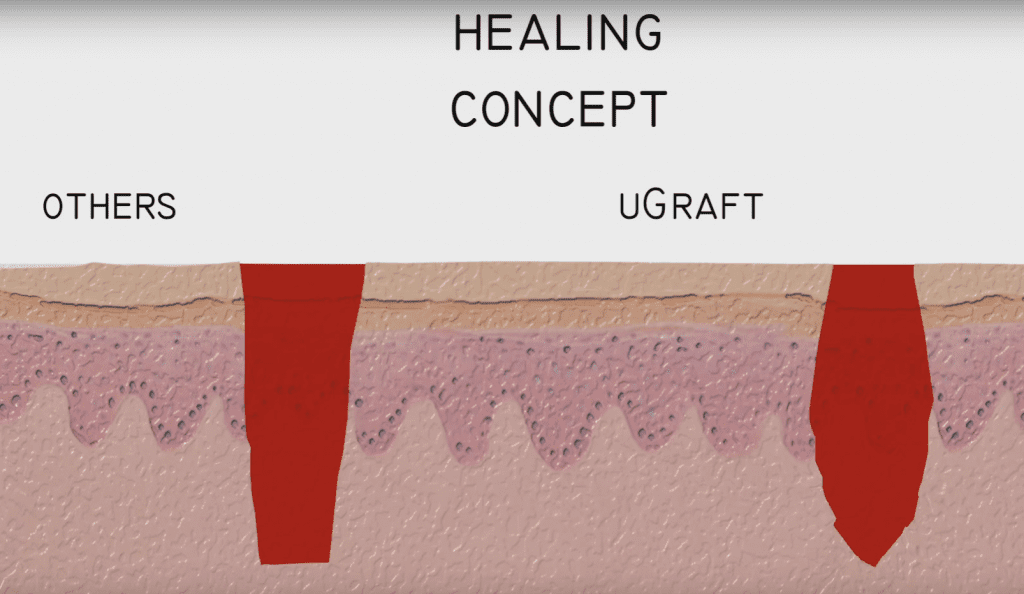
- The shape of the wound left by Dr.UGraft lends itself to faster, cleaner healing as opposed to other FUE methods.
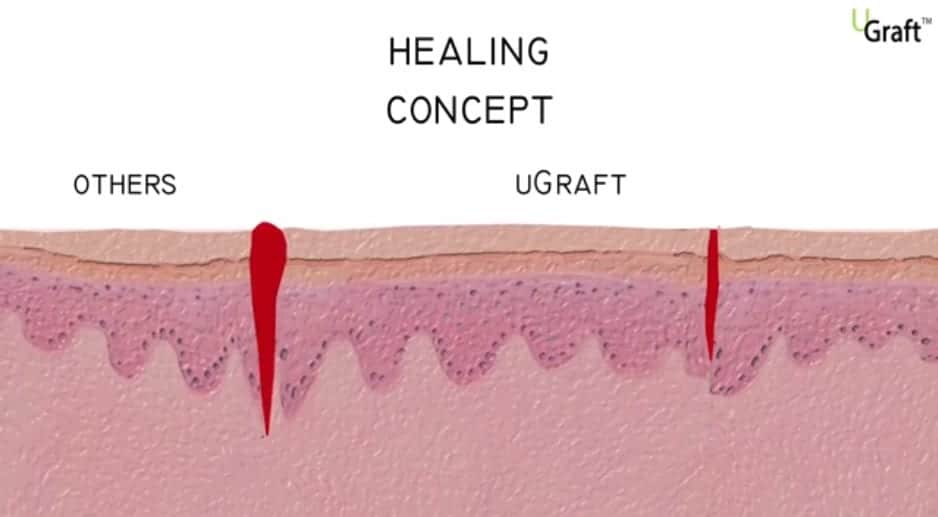
- FUE transplant recovery: Other FUE methods leave a larger wound more prone to scarring, while Dr.UGraft leaves a smaller incision with wounds that heal in a month or less.
What to Expect After a Hair Transplant by Skin Type
Skin type plays a critical role in wound healing. Using the Fitzpatrick scale, it becomes simple to categorize the amount of melanin in the skin. The Fitzpatrick scale also shows how the sun can affect the dermis.
- Type 1 – extremely pale and fair with blonde or red hair; the skin will freckle or burn with excessive exposure to the sun.
- Type 2 – fair coloration with blonde or red hair; minimal skin tanning, but sunburns are the most prominent.
- Type 3 – skin is pale but more cream-colored; tanning can be achieved uniformly, and sunburning is minimal.
- Type 4 – skin coloration is medium brown or Mediterranean olive; tanning is easily achieved, and burning is rare.
- Type 5 – skin is dark brown and characteristic of the Middle East; tanning is easily achieved, and burning is rare.
- Type 6 – skin is dark brown/black, never burns, and tans easily.
Certain skin types develop specific FUE wound healing patterns after hair transplantation procedures. Therefore, a patient should know his skin type to anticipate the kind of wound healing patterns he will encounter after his operation.
Different Possibilities During the Hair Transplant Recovery Period
Patients can expect several different wound healing patterns following surgery:
– FUE Dyschromia
Patients with Fitzpatrick skin types 3-6 are more prone to healing with dyschromia, the skin’s reaction to recent injuries. As a result, the skin changes colors at the wound site. There are two types of dyschromia: hyperpigmentation and hypopigmentation.
– FUE Dark Spots (Hyperpigmentation)
In hyperpigmentation, the skin darkens during healing. Small brown spots can develop as the skin heals from the extractions. This happens when the skin produces high levels of melanin. Wounds make the skin more vulnerable to the damage that UV light can cause. Therefore, the body overproduces melanin to avoid damage and serve as a type of sunscreen for the wound. This occurs in skin types 3-6.
Hyperpigmentation usually resolves spontaneously over time. Stubborn brown spots can fade with the use of hydroquinone and laser treatment if results are desired immediately.
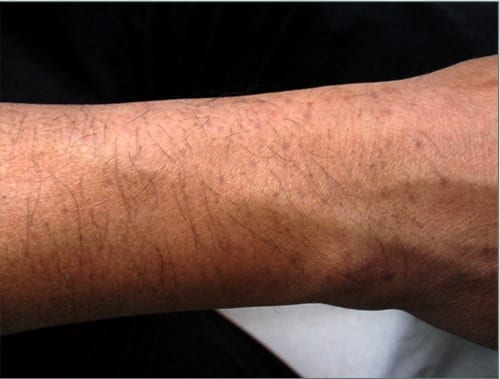
– FUE White Dots and FUE White Dot Scarring (Hypopigmentation)
The famed head FUE white dot or white dot scarring signifies hyperpigmentation, which occurs if the skin loses its ability to produce a normal amount of melanin. It manifests as white dots at the point of FU extraction. There are three major influences of FUE white dotting:
- It occurs more commonly in darker-skinned individuals with Fitzpatrick 4-6 skin types. However, it can happen in light-skinned Caucasians. In very light-skinned individuals, however, it is less visible because of the lesser contrast between the white dot and the surrounding skin/scalp.
- The size of the wound has a large role to play in the incident and severity of the FUE white dots. Larger punches generally would have a higher incidence of FUE white dotting compared to a smaller FUE punch of a similar configuration.
- Another factor that plays a role in FUE white dots is the configuration of the wound created. Wounds with less-everted wound edges, like those created by the Dr.UGraft Intelligent Punch, have a lesser white dot size than punches that favor wound edge eversion.
The following photos show a patient who underwent several past FUE surgeries before seeing Dr. U for repair. The photo shows FUE white dot scarring and a depleted head donor. It also shows evidence of a past strip surgery and a characteristic linear scar. Many would say the strip scar stands out more.
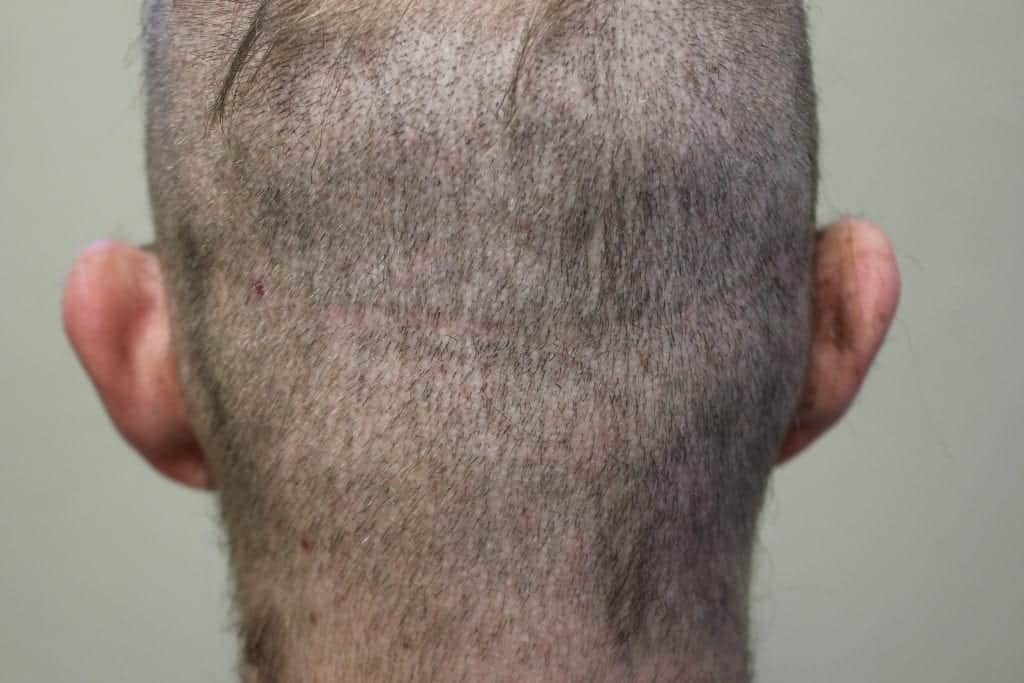
FUE Hypopigmentation (FUE white dottings) is often permanent but can improve with time. Because of the permanence of hypopigmentation, doctors recommend that patients who may experience it should not have body or beard hair transplants.
Video of a Dark-Skinned Patient Who Developed White Dots After Beard Hair Extraction
In this video, a Dr. U patient of East Indian American descent develops tiny white dots in the beard area. Dr. U Used tricopigmentation to resolve the issue, albeit an insignificant one.
Redness
Redness usually develops in patients with lighter skin. These skin types (1-2) experience trauma to the skin from the extractions that causes blood vessels to dilate and the skin to experience inflammation.
After several weeks, the majority of the redness should subside. Individuals with darker skin are not immune to inflammation, which is often masked by the hypopigmentation experienced. Redness usually will resolve within 6 to 8 weeks.
-
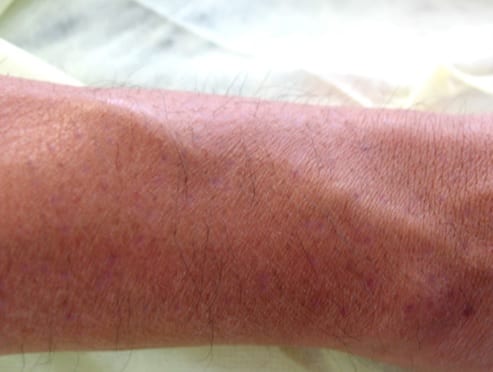
Redness caused by dilated blood vessels is barely noticeable due to hyperpigmentation.*
Bumps from Ingrown Hairs
Bumps can appear due to inflammation of the hair follicles at the extraction site. Although these normally resolve themselves within 6-8 weeks, doctors can prescribe steroids and antibiotics to assist with the healing process.
-
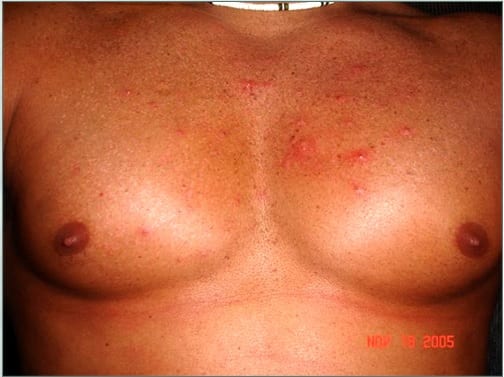
FUE hair transplant recovery: These bumps are caused by wound healing and ingrown hairs.*
General Information on Scarring After Hair Transplants
Scarring occurs during healing and consists of disorganized collagen fibers produced by the skin. Their thick and rubbery appearance is due to the enlargement of individual cells intended to protect the skin from future abrasions.
Visible scarring more often appears in individuals with darker skin tones. Scarring occurs in two main types:
– Hypertrophic Scarring
Hypertrophic scars are generally raised scar tissue. These scars tend to undergo remodeling and spontaneously improve over time. Doctors can accelerate the process over time using several different methods, including steroid injections, creams, silicone therapies, and massages.
– Keloids
Keloid scars are raised above the skin as well but in a more prominent way. Keloid growth begins outside of the wound and continues to grow tumor-like, often from a genetic predisposition. The tumor-like shape and size of keloids make them hard to miss. Keloids require intervention, and doctors treat them through many processes, including steroid creams or injections, silicone-based treatments, interferon, surgery, or radiation treatment.
Individuals prone to keloid scarring should tell their surgeon and avoid unnecessary procedures. These scars can occur in highly visible areas and create feelings of distress and unease. Rest assured, though; proper treatment can improve and mitigate the development of these issues.
The images below provide examples of Dr. UGraft’s wound healing processes for patients of Dr. Umar.
This patient had 2,500 grafts taken from his arm.
-
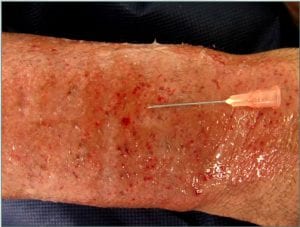
FUE hair transplant recovery time: Donor region used in hair transplant post-surgery, 4-8 hours after extraction.*
The next photo shows the same patient three weeks later. He exhibits excellent Dr.UGraft advanced FUE wound healing results.
-
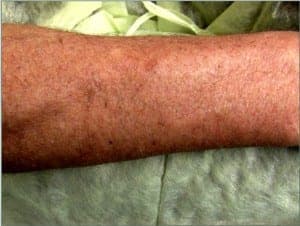
Hair Transplant recovery period: Donor region at three weeks post-surgery.*
This is the same arm with direct lighting. The incisions are almost invisible, and his hyperpigmentation is already beginning to fade.
-
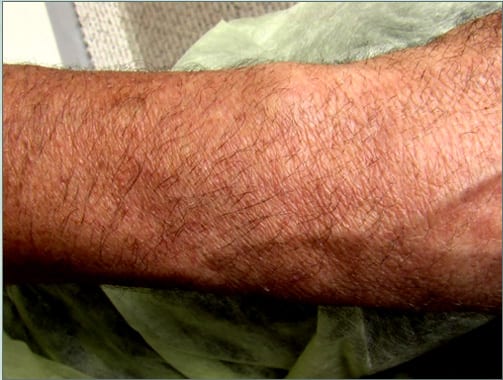
FUE hair transplant recovery time: Same donor region, 3 weeks post-op, with direct light.*
Why Patients Choose Dr. Umar
Patients should always research wound healing when learning about body hair transplants and FUE wound healing. Dr. Umar has experience with all different skin types and can control all healing aspects that other hair transplant surgeons may leave to chance. He knows that wound size and configuration contribute to the healing of wounds. Part of Dr. Umar’s acclaim as a surgeon comes from his knowledge of preventing scarring as FUE healing occurs.
-
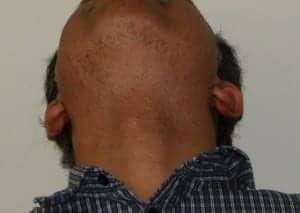
Patients of Indian descent post-BHT after extractions have healed.*
With the Dr.UGraft system, Dr. Umar can perform procedures with body hair, giving hope to patients turned away by other surgeons. His extraction technique has proven more efficient than basic FUE processes and improves FUE wound healing time by extracting hair follicles with a smaller margin of error.
Frequently Asked Questions on Body Hair Transplant and FUE Wound Healing
How many days does FUE wound healing take after my hair transplant?
As each patient is different, what to expect after a hair transplant regarding healing time can vary. In general, wounds tend to heal within a month or so, with full results taking up to a year to develop. Dr.UGraft has minimal risk for complications.
I have scars from previous hair surgeries. Does this make me ineligible for Dr.UGraft FUE?
Not at all! In fact, not only can Dr.UGraft help improve the results of patients dissatisfied with other hair surgeries, it can also help conceal scarring from previous procedures.
When can I wear a hat after hair transplants?
While you may want to cover up the site of your hair transplant as you heal and resume your daily activities, it is important to allow the grafts time to heal and adjust. During the initial healing period, Dr. U will offer individualized instructions regarding what should be avoided and when certain activities, like wearing hats, can resume.
How does the Dr.UGraft body hair transplant differ from other forms of FUE?
Body hair transplant with Dr.UGraft can utilize hair from all over the body, not just the head. For this reason, patients deemed ineligible for hair transplants from other surgeons can receive treatment from Dr. Umar in restoring hair on the head, eyebrows, or eyelashes.
Have more questions about wound healing? Ask Dr. U using the button below.
References
- Umar Sanusi. Body Hair Transplant by Follicular Unit Extraction: My Experience With 122 Patients.Aesthetic Surgery Journal 2016; DOI: 10.1093/asj/sjw089. Published September 22, 2015.
